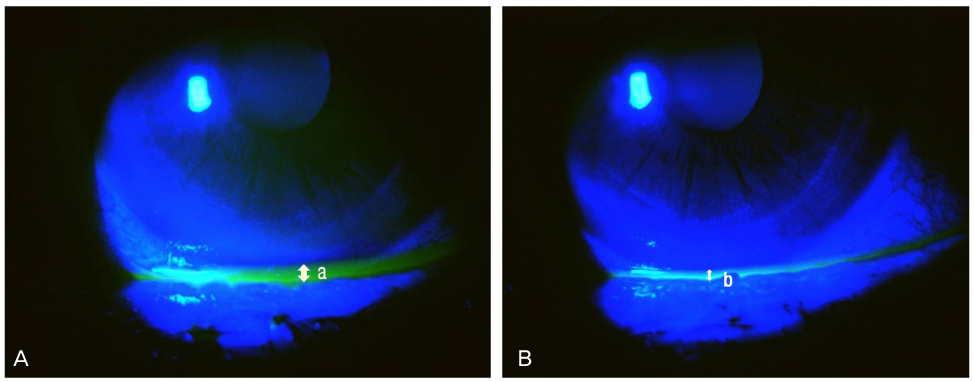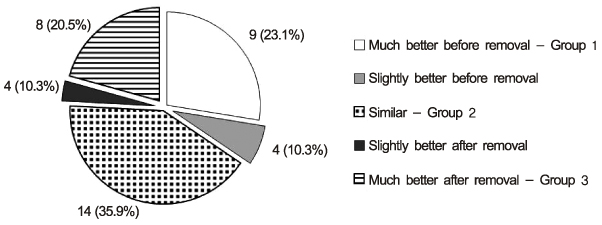J Korean Ophthalmol Soc.
2012 Nov;53(11):1541-1548.
The Influence of a Silicone Tube on Tear Drainage in Patients with Healed Rhinostomy after Dacryocystorhinostomy
- Affiliations
-
- 1Department of Ophthalmology, Ajou University School of Medicine, Suwon, Korea. drkook@ajou.ac.kr
Abstract
- PURPOSE
To evaluate the influence of a silicone tube on tear drainage in patients with a healed rhinostomy site after dacryocystorhinostomy.
METHODS
The subjects of the present study included the patients for whom the removal of a silicone tube was performed after dacryocystorhinostomy for acquired nasolacrimal duct obstruction. The silicone tube was removed after the rhinostomy site was completely healed. The tear drainage function was evaluated using the fluorescein dye disappearance test at the following 3 time points: immediately before, immediately after, and 1 month after silicone tube removal. In addition, a Schirmer test was performed and tear break-up time was measured at each time point. To study the correlation between the measured values and subjective tearing symptoms, self-report questionnaires were given to each patient at his/her last visit.
RESULTS
The 3 measured values showed no statistical difference between the 3 time points, immediately before, immediately after, and 1 month after silicone tube removal. When the patients were divided into groups according to their subjective symptomatic changes after silicone tube removal, no group showed statistically significant difference in the 3 measured values before, between, and after silicone tube removal.
CONCLUSIONS
In patients with a healed rhinostomy site after dacryocystorhinostomy, the removal of the silicone tube did not induce a change of tear drainage function. Therefore, based on the results from the present study, a silicone tube may not have influence on tear drainage functions.
MeSH Terms
Figure
Reference
-
1. Davies MJ, Lee S, Lemke S, Ghabrial R. Predictors of anatomical patency following primary endonasal dacryocystorhinostomy: a pilot study. Orbit. 2011. 30:49–53.2. Güler Z, Suat HU, Alp U. Complications and surface reaction associated with silicone intubation. Orbit. 1997. 16:193–199.3. Smirnov G, Tuomilehto H, Teräsvirta M, et al. Silicone tubing is not necessary after primary endoscopic dacryocystorhinostomy: a prospective randomized study. Am J Rhinol. 2008. 22:214–217.4. Smirnov G, Tuomilehto H, Teräsvirta M, et al. Silicone tubing after endoscopic dacryocystorhinostomy: is it necessary? Am J Rhinol. 2006. 20:600–602.5. Charalampidou S, Fulcher T. Does the timing of silicone tube removal following external dacryocystorhinostomy affect patients' symptoms? Orbit. 2009. 28:115–119.6. Hartikainen J, Grenman R, Puukka P, Seppä H. Prospective randomized comparison of external dacryocystorhinostomy and endonasal laser dacryocystorhinostomy. Ophthalmology. 1998. 105:1106–1113.7. Onerci M. Dacryocystorhinostomy. Diagnosis and treatment of nasolacrimal canal obstructions. Rhinology. 2002. 40:49–65.8. Kim CH, Lew H, Yun YS. Correspondence among the canaliculus irrigation test, dacryocystography and Jones test in the epiphora patients. J Korean Ophthalmol Soc. 2007. 48:1017–1022.9. Joo KS, Lee JK. Comparison of lacrimal scintigraphy and fluorescein dye disappearance test in functional blockage of lacrimal system. J Korean Ophthalmol Soc. 2011. 52:1013–1018.10. Dolmetsch AM. Nonlaser endoscopic endonasal dacryocystorhinostomy with adjunctive Mitomycin C in nasolacrimal duct obstruction in adults. Ophthalmology. 2010. 117:1037–1040.11. Woog JJ, Kennedy RH, Custer PL, et al. Endonasal dacryocystorhinostomy: a report by the American Academy of Ophthalmology. Ophthalmology. 2001. 108:2369–2377.12. Aslan S, Oksuz H, Okuyucu S, et al. Prolene: a novel, cheap, and effective material in dacryocystorhinostomy. Acta Otolaryngol. 2009. 129:755–759.13. Elmorsy S, Fayek HM. Rubber tube versus Silicone tube at the osteotomy site in external dacryocystorhinostomy. Orbit. 2010. 29:76–82.14. Mann BS, Wormald PJ. Endoscopic assessment of the dacryocystorhinostomy ostium after endoscopic surgery. Laryngoscope. 2006. 116:1172–1174.15. Demirci H, Elner VM. Double silicone tube intubation for the management of partial lacrimal system obstruction. Ophthalmology. 2008. 115:383–385.16. Tucker SM, Linberg JV, Nguyen LL, et al. Measurement of the resistance to fluid flow within the lacrimal outflow system. Ophthalmology. 1995. 102:1639–1645.17. Kim HG, Im SK, Park HY, Yoon KC. The changes in tear film after dacryocystorhinostomy. J Korean Ophthalmol Soc. 2010. 51:637–641.
- Full Text Links
- Actions
-
Cited
- CITED
-
- Close
- Share
- Similar articles
-
- Dacryocystorhinostomy with Silicone Tube used in the Lacrimal Drainage System
- Canaliculo-Rhinostomy: Modified Arruga's Procedure
- The Effects of Placement of Bicanalicular Silicon Tube and Silicone Stent on Granuloma Formation in Endoscopic Intranasal Dacryocystorhinostomy
- Cytologic Study of Removed Silicone Tube in Nasolacrimal Duct Obstruction Patients with the Liquid-based Thin Layer Preparation Technique
- Clinical Study on Acute Conjunctivitis after Endoscopic Dacryocystorhinostomy with Silicone Tube Intubation




